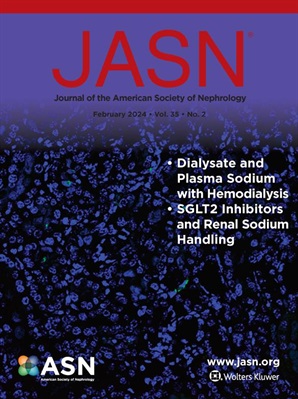Spatial Transcriptomics Reveals Injured Cells, Signature Genes, and Communication Patterns in the Cyst Microenvironment of Polycystic Kidney Disease.
IF 9.4
1区 医学
Q1 UROLOGY & NEPHROLOGY
引用次数: 0
Abstract
BACKGROUND Changes in the cyst microenvironment in Polycystic Kidney Disease (PKD) may drive progressive cyst formation. Bulk- and single-cell RNA sequencing have advanced our understanding of altered signaling; however, the lack of spatial information has limited our insights into local gene expression and cellular communication near cysts. METHODS We used wild-type and Pkd1-deficient mouse kidneys to generate 10x Genomics Visium Spatial Gene Expression datasets. Utilizing our single-cell mouse kidney atlas and single cell sequencing data for spot deconvolution, we enhanced resolution and estimated enriched cell types. We analyzed spatial gene expression patterns and used a cyst-centered analysis to identify cyst-associated gene signature. Cell communication near cysts was investigated, identifying key ligand-receptors. Prioritized key factors were validated in tissues. RESULTS We observed enrichment of fibroblasts, injury-repair-related cell types, and diverse immune populations in PKD. Injury-repair-related cells were exclusively observed in PKD, predominantly localized within immune cell-dense regions near cysts. These cells collectively contributed to the altered gene expression profile in PKD, including cyst-associated signature genes related to inflammatory processes. Analysis of cellular communication in less-inflamed regions around cysts revealed the involvement of multiple cell types. Key ligand-receptor interactions were associated with cytokine signaling, fibrosis, cellular development, and repair. These included Angpt2, C3, Csf1, Cxcl12, Il34, Gas6, Il16, Mdk, Mif, Ptn, Sfrp2, Spp1, Sdc1, Tnc, Tnfsf12, Wnt5a. In addition, ECM proteins implicated in immune response, ECM remodeling, cell adhesion, and cell signaling were identified, such as Adam9, Adam10, Col1a1, Col3a1, Col4a2, Lamb2, Lamc1, Efnb1, Efnb2, Thbs1, Thbs2, and Vcam1. IHC confirmed expression of Syndecan-1-Collagen IV, Midkine-Integrin β1, CSF-1, Pleiotrophin, and Tenascin-C in cystic kidneys. CONCLUSIONS Spatial transcriptomics in PKD revealed enrichment of (myo)fibroblasts, immune, and injury-repair-related cells near cysts, creating a (pro)inflammatory and (pro)fibrotic niche. Key ligand-receptor and ECM interactions were identified and validated.空间转录组学揭示了多囊肾病囊肿微环境中的损伤细胞、特征基因和通讯模式。
多囊肾病(PKD)中囊肿微环境的改变可能驱动囊肿的进行性形成。大细胞和单细胞RNA测序提高了我们对信号改变的理解;然而,空间信息的缺乏限制了我们对囊肿附近局部基因表达和细胞通讯的了解。方法利用野生型和pkd1缺陷小鼠肾脏构建10倍基因组可视化空间基因表达数据集。利用我们的单细胞小鼠肾脏图谱和单细胞测序数据进行斑点反褶积,我们提高了分辨率并估计了富集的细胞类型。我们分析了空间基因表达模式,并使用以囊肿为中心的分析来识别囊肿相关的基因特征。研究了囊肿附近的细胞通讯,鉴定了关键的配体受体。在组织中验证了优先的关键因子。结果我们观察到成纤维细胞、损伤修复相关细胞类型和多种免疫群体在PKD中富集。损伤修复相关细胞仅在PKD中观察到,主要定位于囊肿附近的免疫细胞密集区域。这些细胞共同促成了PKD中基因表达谱的改变,包括与炎症过程相关的囊肿相关特征基因。对囊肿周围炎症程度较低区域的细胞通讯的分析揭示了多种细胞类型的参与。关键的配体-受体相互作用与细胞因子信号、纤维化、细胞发育和修复有关。包括Angpt2、C3、Csf1、Cxcl12、Il34、Gas6、Il16、Mdk、Mif、Ptn、strp2、Spp1、Sdc1、Tnc、Tnfsf12、Wnt5a。此外,还发现了与免疫应答、ECM重塑、细胞粘附和细胞信号传导相关的ECM蛋白,如Adam9、Adam10、Col1a1、Col3a1、Col4a2、Lamb2、Lamc1、Efnb1、Efnb2、Thbs1、Thbs2和Vcam1。免疫组化证实了囊肾中Syndecan-1-Collagen IV、Midkine-Integrin β1、CSF-1、Pleiotrophin和Tenascin-C的表达。结论PKD的空间转录组学显示,(肌)成纤维细胞、免疫和损伤修复相关细胞在囊肿附近富集,形成(亲)炎症和(亲)纤维化生态位。鉴定并验证了关键的配体-受体和ECM相互作用。
本文章由计算机程序翻译,如有差异,请以英文原文为准。
求助全文
约1分钟内获得全文
求助全文
来源期刊
CiteScore
22.40
自引率
2.90%
发文量
492
审稿时长
3-8 weeks
期刊介绍:
The Journal of the American Society of Nephrology (JASN) stands as the preeminent kidney journal globally, offering an exceptional synthesis of cutting-edge basic research, clinical epidemiology, meta-analysis, and relevant editorial content. Representing a comprehensive resource, JASN encompasses clinical research, editorials distilling key findings, perspectives, and timely reviews.
Editorials are skillfully crafted to elucidate the essential insights of the parent article, while JASN actively encourages the submission of Letters to the Editor discussing recently published articles. The reviews featured in JASN are consistently erudite and comprehensive, providing thorough coverage of respective fields. Since its inception in July 1990, JASN has been a monthly publication.
JASN publishes original research reports and editorial content across a spectrum of basic and clinical science relevant to the broad discipline of nephrology. Topics covered include renal cell biology, developmental biology of the kidney, genetics of kidney disease, cell and transport physiology, hemodynamics and vascular regulation, mechanisms of blood pressure regulation, renal immunology, kidney pathology, pathophysiology of kidney diseases, nephrolithiasis, clinical nephrology (including dialysis and transplantation), and hypertension. Furthermore, articles addressing healthcare policy and care delivery issues relevant to nephrology are warmly welcomed.

 求助内容:
求助内容: 应助结果提醒方式:
应助结果提醒方式:


